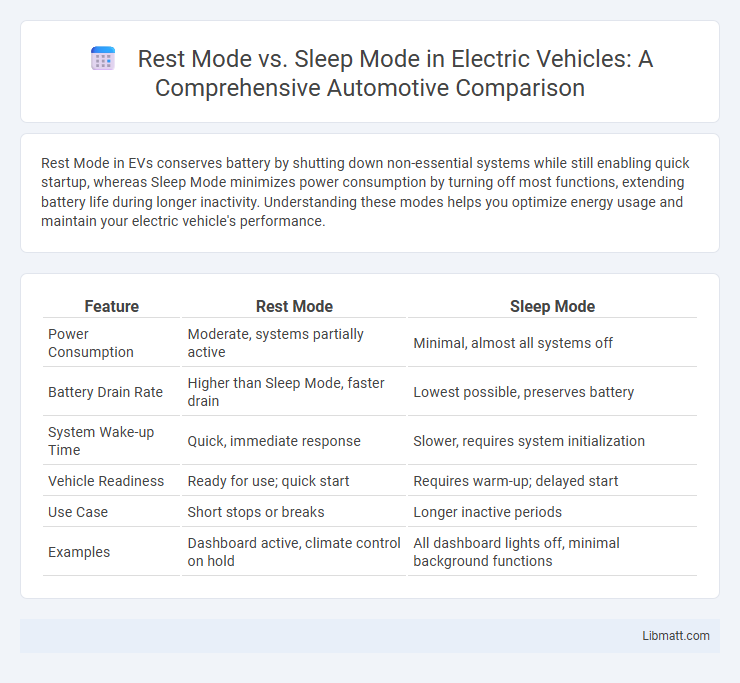Rest Mode in EVs conserves battery by shutting down non-essential systems while still enabling quick startup, whereas Sleep Mode minimizes power consumption by turning off most functions, extending battery life during longer inactivity. Understanding these modes helps you optimize energy usage and maintain your electric vehicle's performance.
Table of Comparison
| Feature | Rest Mode | Sleep Mode |
|---|---|---|
| Power Consumption | Moderate, systems partially active | Minimal, almost all systems off |
| Battery Drain Rate | Higher than Sleep Mode, faster drain | Lowest possible, preserves battery |
| System Wake-up Time | Quick, immediate response | Slower, requires system initialization |
| Vehicle Readiness | Ready for use; quick start | Requires warm-up; delayed start |
| Use Case | Short stops or breaks | Longer inactive periods |
| Examples | Dashboard active, climate control on hold | All dashboard lights off, minimal background functions |
Introduction: Understanding Rest Mode and Sleep Mode in EVs
Rest Mode in electric vehicles (EVs) conserves battery power by reducing energy consumption while maintaining essential functions like climate control and infotainment systems. Sleep Mode further minimizes power usage by shutting down most non-critical systems, allowing the EV to enter a near-complete shutdown state for extended periods of inactivity. Differentiating between these modes helps maximize battery efficiency and ensures optimal performance during vehicle downtime.
Defining Rest Mode: Features and Functionality
Rest Mode in electric vehicles conserves battery power by reducing non-essential functions while maintaining critical systems like climate control and connectivity. This mode allows the vehicle to stay partially active for functions such as cabin temperature regulation and remote app interactions without fully depleting the battery. Rest Mode balances energy efficiency with comfort and convenience, extending battery life compared to full operation or sleep mode.
Exploring Sleep Mode: How It Works in Electric Vehicles
Sleep Mode in electric vehicles conserves battery power by shutting down non-essential systems while maintaining critical functions like monitoring battery health and facilitating quick wake-up response. This mode reduces energy consumption significantly compared to regular operational states, extending overall battery life and enhancing your EV's efficiency during idle periods. Understanding how Sleep Mode activates and manages power draw helps optimize vehicle performance and ensures readiness when you resume driving.
Key Differences Between Rest Mode and Sleep Mode
Rest Mode in EVs maintains essential functions like climate control and battery management with minimal power consumption, whereas Sleep Mode significantly reduces energy use by shutting down non-critical systems. Rest Mode allows quicker vehicle readiness and system responsiveness, while Sleep Mode extends battery preservation during longer periods of inactivity. Understanding the key differences helps you optimize your electric vehicle's energy efficiency and performance based on your usage patterns.
Energy Consumption: Rest Mode vs Sleep Mode
Rest Mode in electric vehicles typically consumes slightly more energy than Sleep Mode, as certain systems like climate control or battery management remain active to maintain optimal conditions. Sleep Mode minimizes energy usage by shutting down most non-essential functions, allowing only critical systems to operate at a low power state. This difference can result in Rest Mode draining the battery faster during extended periods of inactivity compared to Sleep Mode.
Impact on Battery Life and Longevity
Rest Mode in EVs conserves energy by shutting down most systems while maintaining essential functions, resulting in minimal battery drain and promoting longer battery longevity. Sleep Mode reduces power consumption less aggressively, allowing faster startup but leading to slightly higher battery usage that may impact long-term battery health if used excessively. Your choice between these modes directly affects battery life management by balancing immediate convenience with overall battery preservation.
User Experience: Which Mode Is More Convenient?
Rest Mode in EVs offers greater convenience by maintaining essential systems like climate control and app connectivity, allowing you to quickly resume driving without waiting for the vehicle to power up fully. Sleep Mode conserves more energy by shutting down non-essential functions but may result in longer wake-up times and limited remote access. For users prioritizing seamless access and comfort, Rest Mode enhances the overall driving experience by balancing energy use with immediate availability.
Security and System Updates in Both Modes
Rest mode in electric vehicles maintains essential security protocols and allows for critical system updates without fully powering the vehicle, ensuring ongoing protection and performance optimization. Sleep mode minimizes power consumption by shutting down most systems, limiting the ability to perform updates and reducing active security monitoring. Choosing rest mode ensures continuous cybersecurity defenses and timely software enhancements, while sleep mode prioritizes battery conservation at the expense of immediate update installation.
Best Practices for Using Rest and Sleep Modes
Rest mode in EVs conserves battery power by maintaining essential system functions with minimal energy use, ideal when short stops are anticipated. Sleep mode further reduces power consumption by shutting down most non-critical systems, best used during extended periods of inactivity to maximize battery preservation. For optimal battery health and efficiency, engage rest mode during brief breaks and sleep mode during long-term parking or overnight storage.
Conclusion: Choosing the Optimal Mode for Your EV
Choosing the optimal mode for your EV depends on balancing energy efficiency and quick accessibility. Rest Mode conserves more battery by limiting power use, ideal for longer stops, while Sleep Mode allows faster wake-up but consumes slightly more energy. Assess your typical usage patterns to select the mode that best maintains your EV's range and performance without compromising convenience.
Rest Mode vs Sleep Mode (in EVs) Infographic

 libmatt.com
libmatt.com